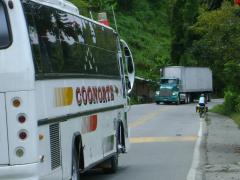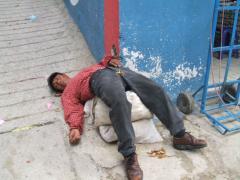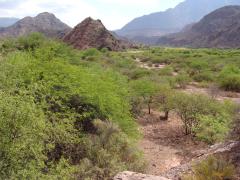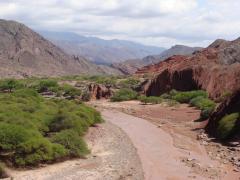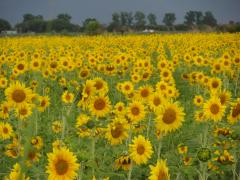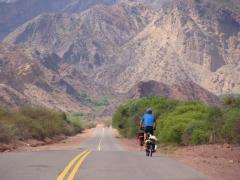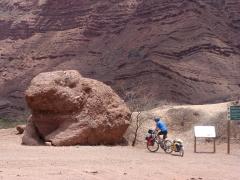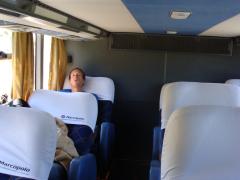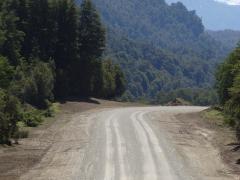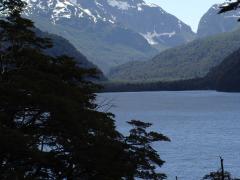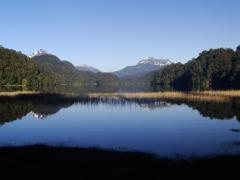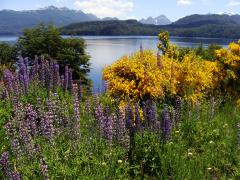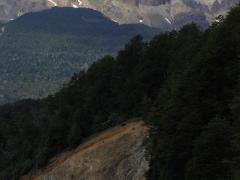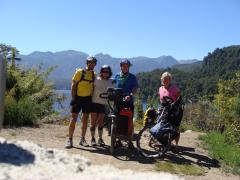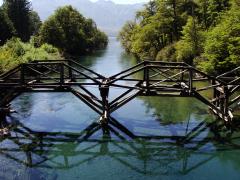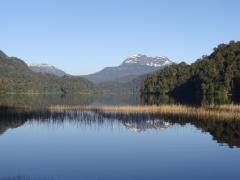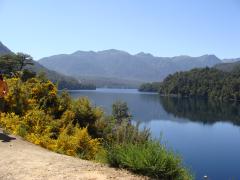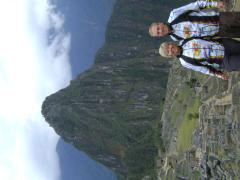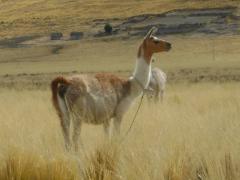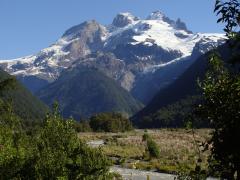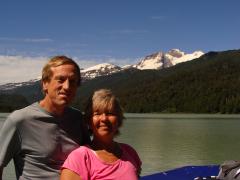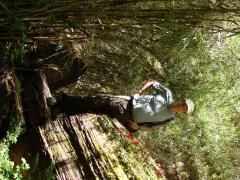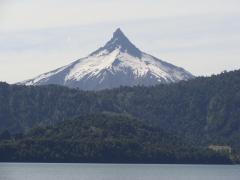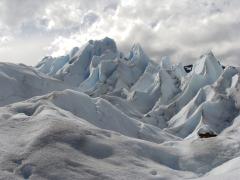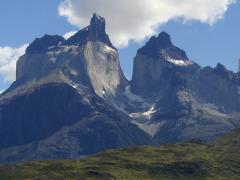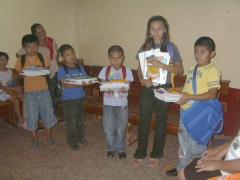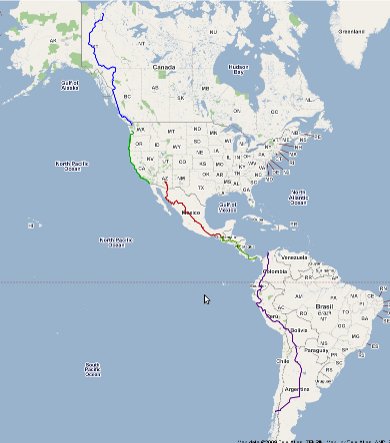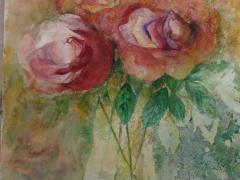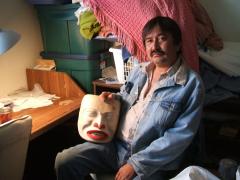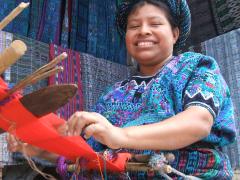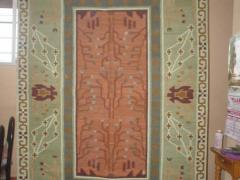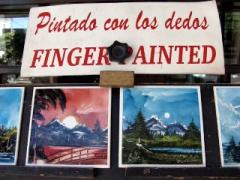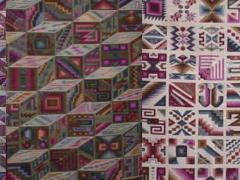Trip Blog
Toll Roads and Cyclists in Latin America
Cyclists occasionally ask us about our experience on toll roads in Latin America, so I thought I'd give a little overview. We've ridden on many of them without trouble.
Throughout Latin America roads have been "privatized", giving a concession to a private company to operate them for a period of years. In general, this means better maintenance on the roads.
We have never been asked to pay a toll on any of the roads we've traveled from Mexico to Argentina. However, we have heard of cyclists being required to pay on some roads in Mexico.
Also in Mexico, we avoided the toll roads but occasionally took them. (We find that the toll roads there are fast and fancy, but you get no sense of the culture of the country.) There was one road (from Pueba to Oaxaca) that was rumored to exclude cyclists. Also, the road from Tijuana to Rosario in Baja California is supposed to rigorously exclude cyclists, forcing them onto a very dangerous, narrow alternate.
In our experience, though: We haven't been excluded from any toll roads, and we haven't been charged tolls.
On occasional, in Mexico and again in Peru, there were specific procedures they wanted us to take when approaching a toll booth. They did not want us to go through the auto lane (because we'd register on a camera?) but rather go completely around the toll booth installation. One time in Mexico, not understanding this, I approached too close and the guard did raise his gun for my benefit.
Latin American Highway Etiquette and Cyclists
We've heard many people complain about motorists in Latin America, we we haven't had a lot of trouble. We actually have quite a lot of respect for the drivers, especially the professional drivers, as they seem to know what to do with us and often do it with courtesy.
However: The more you stay on the busy roads, the more complaints you will have. For example, we often say that there are two experiences cyclists have in Mexico. Those who come down the main highway on the west coast feel like Mexico is one big, busy, ugly highway. Those who mosey down the small roads in the interior of the country feel like it's a wonderful, welcoming, interesting country with reasonable highways.
Here are some of our observations about highway etiquette and getting along on the roads in Latin America:
- We think Latin American drivers are far more skilled than those in North America, since they're used to avoiding all manner of obstacles in the road - not just bicyclists, but also donkeys, dead horses, kids, and the like. They're far more defensive and ready to avoid an obstacle.
- In many countries, there is a specific routine of honking the horn to let cyclists or pedestrians (or anyone else) know that a vehicle is coming from behind. Often this is a quick tap of the horn, but it may be more. It is generally not meant to be offensive, but rather to let you know they're coming. In Guatemala the buses have enormous air-horns, and are honking them all the time, but it's not necessarily to tell you to get out of the way - they're letting people know that the bus is coming and they'll want to get on. However, I don't want to be in the way of any of those Guatemalan buses!
- There is a myth among US cyclists that the bicyclist needs to just take his lane and make the motorist pass. Our opinion is that this just doesn't work in most places, and especially where a motorist may approach suddenly - they won't have enough time to avoid you and you'll be dead. The roads in Latin America are shared, and getting along on them is a matter of cooperation. We get out of the way for the trucks and buses, and they give us a little room. It's all about cooperation.
- If you are riding on a busy, fast road, remember that visibility is crucial. If a motorist has just a fraction of a second more notice that you're there, an accident is that much less likely. When we rode several hundred miles on highway 15, a straight, fast toll road in Sonora with no shoulder, we wore "screaming yellow" vests and could tell the difference. Motorists had just a little more time to move over and get ready to miss us.
- Nancy wrote about riding safety here - one of the key things she said was that when riding together, the partner with the higher tolerance for traffic should ride in back. That way the cars start to get out of the way earlier, and the more-tolerant partner can handle it.
- All that said, the busier the road, the more it all breaks down. If there's too much traffic in too little road, it will just be a nasty experience. That's yet another reason to study the roads ahead, have good maps, and avoid the big roads.
Safety: Riding on Sunday
One thing we heard repeatedly in various people's blogs: "Sunday is a big drinking day in Latin America, so you should avoid riding on Sundays".
Well, they were certainly right about Sunday being a drinking day for the men. Wow, have we seen a lot of blasted men on Sundays. And I'm sure some of those men were driving.
But most people in Latin America do not drive private vehicles, and there is far less traffic on the road on Sundays. So our experience, over and over, has been that Sunday is a great day to cycle. It's also the day that the local sports-cyclists get out and ride. It's the perfect day for cycling.
Putting Your Bike on a Bus in Latin America
We have now used buses in Mexico, Honduras, Costa Rica, Peru, and Bolivia, and have used the train in Mexico and Bolivia.
In the US it's quite a lot of pain to transport your bike by bus or plane - they want you to disassemble it, put it in a box, etc. It's a big deal. But we've had generally good and easy experiences.
- The size of the bus's storage compartment is often the biggest issue. If the bike won't fit, it will have to be disassembled. On a dangerous road in Costa Rica we decided to bail and take a bus and we had to wait overnight for a larger bus with a larger storage compartment.
- Sometimes the bike goes on top. In that case, we try to supervise how it's fastened down. But they seem to be experts. However, it's our bike, and therefore our responsibility. We care about it more than anybody else does.
- Sometimes they have charged us a bit for the bikes, which seems reasonable. It is generally negotiable. Sometimes we haven't been charged at all.
- There is some risk of damage to the bikes, as they rattle around. Normally they come out with some scratch or something that they wouldn't have gotten otherwise. On a couple of dirt roads they have gotten extraordinarily dusty.
- Sometimes when things are very busy you may have to make advance reservations and wait, since baggage compartments may be all full.
Overall, our experiences with buses have been quite satisfactory and easy.
Bike-Dreams: A Supported Ride from Quito to Ushuaia
If you want to ride the length of South America, you don't have to do it self-supported! We ran into a group, Bike Dreams out of Holland riding from Quito, Ecuador to Ushuaia at the tip of Argentina. They are fully supported and having a grand time. For just 8,900 Euros (about $11,400 right now) you could do the entire ride without having to carry gear. It sounds like a pretty good deal. They also do Paris to Dakar.
Bolivia Wrapup
Our pictures for Bolivia are up on flickr - Here's the slideshow of Bolivia and here's the slideshow of the Salar de Uyuni. Also, all our route maps and elevation profiles are updated.
Since we've been in Argentina for weeks, I guess it's time that I wrote a little something to wrap up our time in Bolivia!
We had a delightful time in Bolivia, despite the fact that we were lazy and only rode the bikes two fairly easy days (from the Peruvian border to La Paz). After that we took a bus to Uyuni, a tour of the Salar de Uyuni, and then a train to the border at Villazon. (We did get back on the bikes to ride to where we currently are in northern Argentina, in Salta).
Something is always going on politically in Bolivia, and our time there was no exception. You've probably heard about the tension between Bolivia (and Venezuela) and the U.S., and just before we arrived the US Ambassador was asked to leave the country because he was accused of instigating demonstrations in favor of breaking up the country. The current president, Evo Morales, is a campesino (he started his career growing coca!) and is clearly a populist leftist, and has lots of challenges ahead of him. And he is often poking at the US, along with his compatriot Hugo Chavez, of Venezuela.
Of course, the US is poking back, as always. Maybe they were involved in those demonstrations. Probably they were involved in making Bolivia look bad by pulling the Peace Corps out of the country and shutting down airline flights and acting like they were going to evacuate all Americans when there really wasn't taht much happening. You may have seen the headlines about American Airlines canceling all its flights... But did you see any headlines when they started flying just two weeks later? Or any analysis of why they stopped flying? There wasn't any.
Anyway, when we were there, there was nothing very radical going on. There was a huge campesino march on the capital to support a referendum about a new constitution. And it was all peaceful. Nancy went out to talk to the folks and take some pictures. We saw parades. La Paz was just a very nice, very tourist-friendly place, with an enormous number of services for tourists. We were astounded. Bolivia probably had more tourist activities available than Quito, Ecuador, and was probably on a par with that Disneyland of all Latin American tourists, Costa Rica.
Some prices of things:
- Hotel - nice room with private bath and cable TV: About $14
- Internet - About $0.30/hour in La Paz, more expensive elsewhere.
- Set meal for lunch or dinner: About $1.00. However, we ate a delightful meal at a Middle-Eastern restaurant for less than $5.00 for the two of us.
Our route notes and pointers to route resources and maps are on the Bolivia Route Page.
Greetings from Patagonia!
We are in Bariloche, in Patagonia in southern Argentina. We have rented an apartment for a month and will enjoy a gorgeous place with fine weather. As winter approaches in the Northern Hemisphere, we will be exploring the lakes district which is surrounded by snow-capped mountains and spring weather. Please let me know if you are sufficiently jealous.
We rode from Salta, Argentina, a jazzy city in Northern Argentina, through the Canyon of the Shells (Quebrada de Las Conchas or Quebrada de Cafayate) an impressive multi-colored landscape with interesting geological and cultural history. As my friend, Linda, described It is like Moab, Utah but with more pizazz. The landscape was inspiring as we traveled down the las Conchas Ravine and colorful sedimentary mountains towered over us. I was gleeful to be riding. Amazed at that we where riding this region in Northern Argentina. How lucky can we be?
We camped along a small river in a remote town of Alemanía. It was not a real campground, just a green quiet spot down by the river not too far from the tiny village. When we got there, we set up the tent and relaxed awhile. I sat and drew the landscape with my traveling watercolor kit while Randy worked on the computer he bought in Salta. No surprisingly there was no wifi at our campsite -- there was not even a bathroom. Horses grazed by me, a herd of goats trekked by, stopping to give me a once over. Dogs sat next to me waiting for a morsel. A tracker drove through the river bank. Teenagers came and went. As the day turned into night, incredible magical sounds and sights of nature came to life.
The sky filled with the blinking neon lights of fireflies, a huge toad with his/her mating hitchhiker parked in front of our tent and loudly croaked in competition with other similar boisterous toads. A constant greenish light emanated from large cicada bugs (or something) which mingled with the flashing fireflies. Up and down the river bed we heard the cows moo-ing, donkeys hey-hawed in their protesting way, the sound of passing horses added to the percussion section of this natural symphony. Dogs passed in silence searching for a bit of scraps to eat. The little town was a just a half a kilometer away and we could hear the children playing and laughing in the warm spring night. Randy and I wandered in the night listening to the magical sounds in the valley of the shells truly relishing this magical moment.
Continuing our tour the following morning we rode past strange natural sandstone sculptures and stopped to visit signed points of interest such as the the Devil's Throat, Los Castillos (the Castles), El Obelisco (the Obelisk), El Fraile (the Monk), El Sapo (the Frog), and El Anfiteatro (the Amphitheatre). We reached Cafayate in the late afternoon and found a room at San Jorge, a family owned hostel. It is so easy finding hospitality in Argentina because all have the minimum I like to have. A good bed, hot water, clean and friendly. The only thing I did not anticipate was the hoarsely squawking roosters next door and the barking neurotic dog the next block over. Luckily we have ear plugs which allows us to sleep. Sweet ear plugs, sweet sleep.
Cafayate is one of the premier wine growing regions in Argentina. Because of its high altitude and mild weather, it is the top producing area of the Torronte white wines. I can attest that after trying various kinds, that as long as you spend at least ten peso or over 3 dollars you will get a quality bottle of wine. We toured one vineyard personally, tried a few others but they where closed. We rode our bikes past dozens of highly productive vineyards with a background of poly-colored geological layers. Riding the route south was delightful but by the end of the day, we had come to an important junction on our trip.
We just wanted to finish our adventure, after two years and 5 months, we have ridden 22,000 kilometers, and visited 13 countries. We had set out to learn about the wonderful varying cultures of the America, we had seen endless landscape of inspiring vistas and pedaled our bike threw hellish deserts, eaten traditional foods from all over the Americas, got sick on some. We have enjoyed the generosity of strangers who now are our amigos. We have been called Gringos by strangers and children excited to see us, in return we smiled and waved back at their excitement at seeing two touring bicyclists passing by. I have cried, we have laughed, we have danced and drunk from the well of life. I do not know how many photos we have taken but I might estimate it is over 10,000. Heck, I took over 500 at the Galapagos Island alone. We have spent as many hours in the Internet writing blogs, updating our website and writing to our old and new friends. I have created a ton of watercolors paintings. We even fulfilled our dream of doing volunteer work in Guatemala, Nicaragua and Peru. So after all this we have run short of time, money and desire to ride to the end of this continent. We want to go home. After resting a bit before we go back to the United States and back into a culture that is currently foreign to us.
We loaded our bikes on to a bus for Tucumán and then bought tickets for a 36-hour, 2300 kilometer (1426 mile) bus ride to Bariloche, Argentina, a paradise in the middle of the Lakes district in Patagonia. We have rented an apartment for a month. The apartment is really a converted garage but a nice one with a very big backyard and trees and flowers. We will do some short trips from Bariloche, do some hiking, fishing, kayaking, horseback-riding, drawing and updating of our computer skills. Randy is doing some freelance website programing with Drupal and Nancy is drawing and searching for the right career. So many options it is hard to pin down the correct one. Vamos a ver (we will see). We have many things to still post on the websiteso return to the site for further stories and photos.
We have mixed emotions, of course. Although we got to Argentina, we didn't ride to Patagonia, and we aren't going to get to Ushuaia, the southernmost tip of the continent. On the other hand, what a lot we have seen and done! And there is the future...
PS. So if you are in the neighborhood, come on by. We would love to cook you up a home cooked meal. If you are cycling by we have plenty of floor space to camp on and would love to share our humble abode.
Biking the Seven Lakes (Siete Lagos) District in Patagonia
Even though we are taking a break in Bariloche, Argentina for a month, we are not staying still. One of my dreams for years has to been to ride my bike through the incredibly beautiful Patagonian Seven Lakes, or Siete Lagos district. This past weekend, this dream came through. The plan was take a bus to San Martin de Lost Andes and pedal back along the way we had come to La Angostura along a road that was paved for half paved and half dirt.
We loaded our bikes on a bus departing at 7:00 pm from Bariloche and got to San Martin de los Andes 11:00. We had no trouble loading our two bikes into the back compartment of the bus as they fit perfectly standing up and we didn't even have to take off the wheels. Not all bus service in Argentina will take bikes but after a few phone calls we found out that Albus would take two bikes on each trip. The bus company Aribus was great all the ways: courteous, efficient, clean new buses, safe and best of all, they took our bikes with no fuss. Being able to put our bikes on a bus and travel short or long distances has been one of the nicest parts of traveling in Latin America. No boxes, no fussing, just load and go.
The bus route was exactly the road we'd return on, so we got a sneak preview. From the seat on the bus, it appeared I had underestimated the difficulty of this ride. The road had endless amounts of short ups and downs and it was under serious construction. It was daunting. I watched for hours memorizing the route we would soon be exploring. Meanwhile Randy slept soundly next to me. He only awoke when I would nudge him to get him to mark a point on the GPS and then he fell back into a deep sleep. The last time I remember this type of road and the short steep grades was while riding the Cassiar highway up in Canada. It was nightfall about halfway through the trip and the steep grades were exaggerated by the bright lights emitted from the huge bus. A few cows and deer where also caught by the highs of the bus lights, freezing in place as we came around the blind curves. The driver stopped the bus, lowered head lights from bright to low and waited until the handful of cows lumbered their way across the gravel road and out of harm's way. The headlights of the bus cut a path through the pitch darkness and illuminated the climbs and thick loose gravel. Like looking at things underwater, everything appeared bigger and harder. I told myself over and over, this was my idea, this was my dream, tomorrow I will just shut-up and pedal and enjoy the ride. This was a no whining zone...
We got to San Martin around 11:00 pm and rode to the only campground in town. Even though it was almost midnight the restaurants were in full swing, as this was the standard time many Argentinians eat dinner. The campground was on the edge of town and was not open yet for the season. But after ringing the bell and waking up the manager, he let us in for the night as long as we promised to leave early the next morning. He also told us that there was no bathrooms With this he went and locked the bathroom doors and went away. The next morning the ground workers opened up the ladies room to do some maintenance in which we took it as an invite to take a warm shower and to use the bathroom which of course we were told did not exist. We did leave early for Argentina time, before 9:00. After stopping at the only open grocery store and buying 30 dollars worth of groceries we were provisioned for the our three day adventure.
The first 40 miles were on paved road along countless pristine lakes. Rising out of the glacier waterways were the photographic Andes which reflected back onto the mirror lakes. We traveled from one National Park to another. Capturing great photos was so easy. It had all the elements which make for stunning images. Bright clear sunlight, rich blue sky, snow covered mountains, tree covered foothills, glacier-fed lakes and meadows of spring flowers. Take enough photos and one or two have to come up right. I find riding a bike a great way to explore an area and shot photography because we can stop anytime and spend as long as we want.
We passed a beautiful campground at Lake Falkner which called to us but we continued on and made more miles. We wanted finish the pavement and to get some of the riding on the dirt road out of the way so we would not have to ride some many miles on dirt the next day. Just as we got on to the dirt road, it started to rain. We got our rain gear out for the first time since northern Peru. It usual happens that as soon as we get our rain gear on it stops. This was the case. The rain stopped after 10 minutes of light rain. Late in the afternoon we made it to the campground Pichi Traful, a glorious spot along the lake and along a crystal clear river. We camped down the river a bit away from most of the campers, in order to enjoy the solitude of nature. We met a Dutch cycling couple, Clara and Rolf, and shared some tea and stories of the road.
That night it was hot so we kept the front of the tent wide open and slept well. My handlebar bag which was at the entrance of the tent when I went to sleep was gone in the morning. It was missing! My new camera, prescription sunglasses, a copy of my passport, a change purse with a few pesos, and my beloved rear-view mirror were missing. I was so confused and distraught. We unpacked everything. and searched through our gear. I searched the whole campground and surrounding area thinking I left it somewhere or perhaps someone stole it and discarded it. I was heartbroken because my new camera was gone. I reported the missing bag to the caretaker of the campground who in return called the park ranger who in return called the police on the radio. After an hour or two of waiting for the police, I was told they were busy with a competition and could not drive the 50 kilometers to investigate the problem.
I felt helpless and wanted to do something about this situation. I wanted to find my bag and its contents. Randy told me it was impossible and that I would never get it back. I went and talked a group of young men nearest to our campground. They had been partying hard the night before and I suspected they had something to do with the missing bag. They talked about a young man who had been partying with them but they really did not know well but they new his name was Saul and he wore a bandanna. Saul had left their campsite about one o'clock in the morning very drunk and headed past our campsite oh his way home or wherever he slept. I reported this information to the campground manager, he and a posse of 4 other workers headed out in search of Saul. They knew Saul was trouble. A short period later, the group of 5 returned with my bag and all of it's contents. It was an amazing sight to see, all my stuff had been recovered. It turned out the drunk thief passed our tent on his way back home and grabbed my bag. He was so drunk he passed out with my big bag lying right next to him and they found him senseless on the ground with my bag and some other goodies from other campsites. I still am amazed at the stupidity of this young ma. Luckily for me, he was a complete failure at being a crook. He should take up some other occupation. I am very thankful for the guys who run the park that they took my report seriously and searched out the robber. In the end the campground will continue to have trouble with the nitwit because no legal charges can be made against him because the items were recovered.
We finally left the campground after noon and pedaled the stretch I had concerns about. To make matters worse there was giant horseflies that bit us every time we stopped or slowed down. The buggers even bit us through our bike gloves. I killed as many as I could with great satisfaction. The ride was physically challenging but was not as bad as my imagination had made it. Yes it was hilly, dusty and the road had loose gravel but it was beautiful. Stunning! It was just like I had dreamed the views would be. No, even richer and more beautiful. We camped at the lake called Espejo Chico (small mirror) and set up our tent overlooking the lake which indeed is like a mirror. After buying a liter of Quilmes beer from the small camp store, we sat on the beach and watched the sunset dip behind the glacier-carved mountains. With the fading light, day became night. In the still water, I still seethe reflection of day merging into night. The daylight has come and gone and in its place is only the memory of the day. The night embraces the day and holds it safe. It lives on forever in the memory of time.
To me, that evening sunset symbolized a closing of our grand adventure. It is time to wrap things up and head back home. What better place to finish our trip but a Lago Espejo Chico. We have a few more miles to ride but essential it is time to transition away from a life traveling my bicycle.
The next day we continued on our route and cycled to La Angostura where we would take a bus back to Bariloche, avoiding the busy highway around Lake Nahuel Huapi. During the day we met a cycling couple from Argentina and rode with them for the second half of the ride. Chris and Maria live 6 hours north of the Lakes district but was touring the area for the long weekend. The new friends made the day fly and distracted us from our tired muscles. We stopped and cooked lunch along the shore of Lago Espejo Grande. We learned from them about living in Argentina, working, taxes, benefits and health care and retirement. The dirt road turned to pavement and we continued around Lake Nahuel Huapi for a few kilometers, stopping to take some stunning panoramic photos. After reaching town, all four of us washed up at the local gas station and changed into clean clothes. We then did what most bicycle tourists do when arriving to civilization, and went in search for food. We found the best ice cream in the Americas and ordered 3 scoops each. I am talking about a huge bowl of rich cold, full flavored delights: Lemon, Berry and chocolate bites in caramel ice cream called Dulce de Leche. I will be dreaming of that bowl of ice cream for a long time.
All four of us headed to the bus station and said our goodbyes as Randy and I loaded ourselves and our bikes onto the bus for the hour-long trip to Barliloche. As we road back in the luxury of a huge comfortable bus, I reflected on the 3 day trip. The reality was as great as my drea. I can check-o ff that dream from my long list of things I want to do before I leave this big apple.
Hola desde La Patagonia
Saludos a todos nuestros amigos en Latinoamérica - hola desde Bariloche, en Patagonia, Argentina.
La última vez que mandamos una actualización fue a principios de Septiembre, y en ese entonces nos encontramos en Huánuco, Peru, pedaleando las maravillosas pero difíciles montañas del Perú. (Disculpe que no hemos mandado nada desde entonces!) Aquí está una actualización sobre lo que ha pasado desde entonces.
Pasamos una semana en Huancayo y Tarma, Perú haciendo trabajo como voluntarios para Kiva.org y Microfinanzas Prisma. Kiva fue el primer persona-a-persona website de microfinanzas en el mundo que ofrece la oportunidad a personas en el mundo desarrollado que puedan hacer préstamos directamenta (mas o menos) a micro-empresarios en el mundo en desarrollo. Pasamos la semana viajando por bus, taxi, 4x4, y a pié a lugares retirados en los altos y selvas altas del Perú para entrevistar a clientes. Fue divertido y aprendimos mucho conociendo un poco de que están haciendo Kiva y Prisma Microfinanzas.
Entonces continuamos por bici de Huánuco a Ayacucho, Perú, pedeleando por paisajes increíbles de montañas altas y valles de desierto. Pasamos campamentos de minería, pastores con llamas y ovejas, y muchos pueblitos abandonados, un resultado de la violencia del tiempo del conflicto entre en gobierno y el Sendero Luminoso de los años 80 y 90. Nos pareció un lugar muy pesado para vivir: sin agua, no fértil, sin sombra, y con un montón de moscas.
De Ayacucho continuamos por bus a Cusco, para evitar un tramo de ripio y polvo que cruzó cinco pasos muy altos por las montañas. Saliendo de Ayacucho, fuimos a comprar pan afuera del mercado y alguien robó la cámara de Nancy cuando estábamos allí viendo! (Ella compró otra para reemplazarla y está tomando muchas fotos lindas otra vez.)
Nuestra próxima aventura fue a la famosa Machu Picchu cerca de Cusco, donde pasamos por bus el Valle Sagrado de los Inca y por tren a Machu Picchu. Para experimentar completamente el empacto del sitio, subimos a pié del pueblito de Aguas Calientes, partiendo a las cuatro de la mañana. Y el sitio merece su designación como una de las siete nuevas maravillas del mundo - verdaderamente es un lugar de magia. Randy subió a Huayna Picchu mientras que Nancy se sentaba y capturaba todo con su equipo de acuarela.
Desde Cusco montamos por un paso y mucha tierras altas - el altiplano que queda cerca del lago Titicaca y la ciudad de Puno. Como todos los turistas visitamos a las islas retiradas de Amantaní y Taquile y pasamos una noche en la casa de adobe de una familia en la isla.
Continuando por la orilla del Lago Titicaca y nos encantaron las vistas de el agua de verde-azul - seguimos el lago casi hasta La Paz, Bolivia. Durante la semana que nos quedamos en La Paz, vimos manifestaciones por los campesinos exigiendo una nueva constitución. Las manifestaciones fueron completamente pacificas, pero no había ningun forma de transporte ese día. Tenían éxito - será un referéndum sobre la nueva constitución en Enero.
Nancy no podía quitarse de dolores de cabeza y corazón en las regiones montañosas, y por eso decidimos continuar en Bolivia por bus y tren. Fuimos al Salar de Uyuni, una maravilla que fue un mar y ya es un desierto, y visitamos muchos lugares - lagos de varios colores, terrenos extraordinarios con flamingos, termales, y paisajes extraños que inspiraron a Salvador Dali.
De Uyuni tomamos un tren a la frontera con Argentina donde montamos otra vez las bicicletas y seguimos (¡bajando de 3600 metros a 1300 metros de altura!). Por cuatro días pasamos tierras encantadas de formaciones de rocas coloridas, pavimento!, y muchas llamas y ovejas. Todo se hizo mucho mas fácil que en los otros países de los Andes: agua potable en la llave, agua caliente, vinos fabulosos, y buena carne. Acampamos al lado de una iglesia abandonada y detrás de unos árboles para escapar el viento. Cuando Randy se hizo enfermo con bronquitis, descansamos unos días en Salta en la casa de ciclistas allá (¡gracias, Ramón, Tina, y la familia Marín!). También pasamos dos noches con Tomás y Nadia (una pareja que se lista en Warmshowers.org). Por fin llegamos en el pueblito cerca de San Lorenzo, donde nos quedamos mas de una semana al Hostal Tatata, un verdadero paraíso. Randy se recuperó y hizo un poco de trabajo por internet (para diversión y también para ganar un poco de plata.) y Nancy hizo un proyecto de mucho dibujo y acuarela.
Por fin salimos de Salta y montamos 4 días al sur al centro de vinería famoso de Cafayate, y de Cafayate montamos solo un día mas antes de que tomamos la decisión de tomar un bus hasta Bariloche, en Patagonia, donde estamos ahora. Pensamos que este lugar tan bonito es mas o menos en término del viaje. Hemos llegado a Argentina, al sur (aunque una gran parte de Bolivia y Argentina fue por bus) y vamos a descansar aquí un rato - hasta enero - y proceder a Santiago de Chile para regresar a los estados unidos.
Como siempre, tenemos muchas historias en hobobiker.com - y hay una traducción automática de todo.
Y tenemos un montón de fotos, mucho mas que hay en el website:.
-
El Sur del Perú (o como slideshow)
-
El Salar de Uyuni (o como slideshow )
-
El Norte de Argentina (o como slideshow )
Muchas gracias a todos ustedes por seguir con nosotros! Siempre sentimos su amistad.
Gracias,
-Randy y Nancy
Biking and Boating the "Andean Lakes Crossing" into Chile
Click here for our favorite pictures from this section.
We took an incredible bike-and-boat tour from Argentina to Chile. The "Andean Lakes Crossing" combined boat rides through two majestic thickly forested national parks, hiking, and biking touring. We started from Bariloche, Argentina and ended up in Puerto Montt, Chile.
We emptied out the apartment we had been renting in Bariloche, Argentina and loaded our bikes with the gear that had been spread out all over the apartment for the last month. My bike was heavier then usual because I had purchased some new clothes and art supplies but some how it fit, especially because I offloaded some of the art supplies to Randy. We left at 6:00 in the morning, pedaled 20 quiet kilometers to the boat dock at Llao Llao (pronounced Zhao-Zhao in Argentina). After loading our bikes on to the front of the giant catamaran and purchasing a nice cup of cappuccino we settled down for first of three boat rides. The first was across Lago Nahuel Huapi which was surrounded by huge mountains and we reached Puerto Blest after a couple of hours.
We disembarked and rode an easy 3k for the next short boat cruise across Lago Frías. While cruising through the calm waters we came around a corner and there in front was the majestic volcano Tronador. The snow-covered triple-peaked volcano shone more brightly under the clear blue mid-day sky. It was so close and big, it felt like I could reach out and touch the mountain. We stashed our bikes at the next landing and went for a hike in the wild Patagonian forest. Mostly we followed a river which was gray from the glacial silt that washed down the river in the currents and rapids. We crossed the river once on a huge fallen tree which also had a ratty network of guide wires strung for hand holds. It was rather scary crossing the natural bridge and scarier as the tree narrowed to next to nothing on the other side of the river. We continued the trek through bamboo forests and holly bushes. I had worn shorts and should have known better. The path we took was very wild and overgrown so I got scratched by the sharp edges of the low growing holly. After a few hours we returned back to continue on with our bike tour.
We had been warned about our final 3 kilometers in Argentina, and we knew we'd be pushing our bikes. And we were. We dragged our bikes up that monster, but it was only a short ways and only about 250 meters of climbing, but oh, so steep and loose. The back of my calves ached after the two hour of pushing and we crested the pass. The next part was down hill for 8 kilometers but we had to ride slowly as the road was lined with large loose gravel waiting for us to blow it. Randy did lay down his bike but he somehow managed to run out of the fall and was standing laughing as his bike and trailer laid still in the middle of the dirt road with the back wheel going around and around.
We camped in front of the Chilean border post. Since this was a national park which prohibited camping the only two official places were a hiking campground and a the border guard house. I must say that the camping was lovely. We had the whole place to ourselves, the use of the bathroom, access to clean drinking water and a the very best view of the Volcano Tronador with its massive glaciers hanging on the the steep ridges. It was the best view of any volcano we have seen anywhere on our trip.
The only really bad part of this ride was the monster horse flies. The must be on steroids as they are twice the size of any I have ever seen. They are black with bright orange underbodies. They can fly more then 15 miles an hour and they swarm. Darwin's theory of the survival of the fittest is in effect in these parts of Argentina/Chile. The slow flies get killed and can not reproduce. Let me tell you how satisfying it is killing these creatures, oh it is a great feeling. The horse flies which can fly 15 kilometers an hour, kept up with us. They waited until we stopped for just a second and stung us through our clothes. Those that can fly fast get fed. Those that fly slowly, die of starvation. The mighty live on to reproduce and continue the gene poll of monster horse-fly-dom.
We reached the small village of Peulla where we had to wait for 4 hours for last boat crossing. As we waited, I was in need of a shower to wash all the grit off. I asked at the homely yet expensive hotel if we could take a shower in a room that had not been cleaned yet. The desk clerk gave us a key to room 113 where we enjoyed a bath and a shower. Afterwards I returned the key to the desk clerk along with a tip. It was nice for him to risk his job so we could be more presentable for the last leg of this boat crossing.
This time we traveled across the gigantic lake Llanquihue and past the impressive classical shaped volcano Osorno. It was even more impressive because it came right out of the lake and raised thousands of meters straight up. The top was draped with crisp white snow.
Everyday of this three day trip had biking challenges. The next road was under construction and lined with a inches of ash. Every time a bus rushed by we got a face and lung full of the loss powder. After 27 kilometers, we reached pavement and headed to the grocery store and campground. This night was New Years eve and all the stores would be closed the next day so we had to buy supplies to last the next day and half. The campground was run down but offered pretty views of the lake Llanquihue. We enjoyed a glass of wine at the beach and reflected on the past year as we watched setting sun reflect off the volcano Osorno. We did go out to dinner at don salmon and had a delicious salmon meal. The campground came alive around 11:30 and final went to sleep around 4:00. We on the other hand where in bed by 11:30 and slept through most of the party.
The final leg of this trip took us into Puerto Montt. The winds were strong and blew us all over. The 40 mile ride seemed like a hundred. The traffic was light, though, and we arrived in a city that was completely quiet for the New Year's holiday. We did manage to find a very nice hostel that took us in for the night, Hospedaje Familiar Nelda. A helpful and open family which run a hostal in a large seaport style wooden home. It is a place which is clean and has a lot of character and great beds.
We are going to store our bikes there for two weeks as we take a plane south to tour the Torres del Paine National Park (in Chile) and go to El Calafate in Argentina, where we'll see the famous glacier Perito Moreno. Then we return here, take a bus to Santiago, and on January 14, we have a flight to Miami, Florida, in the US, where we'll ride to Nancy's dad's place in Naples, on the other side of the Peninsula.
Thanks for following along!
Updated website - let me know if there are problems
We've been hiking the last several days in far southern Patagonia, and visited the amazing Perito Moreno Glacier.
I've just updated the website to a new version of drupal, so please let me know if you have any problems with the site or there's anything I've messed up.
Thanks,
-Randy
PS - We have a flight to Florida on Wednesday!
Torres del Paine and the Perito Moreno Glacier
Oh by the way, did we mention we have finished our bike ride? Yep, we rode the last bit from Bariloche, Argentina to Puerto Montt, Chile. After over two and half years and pedaling over 22,000 Kilometers (almost 14,000 miles) we have reached a place we consider a final ending point of our north-to-south journey.
After spending a wonderful month in Bariloche, Argentina cycling unloaded, hiking, Randy working remotely and Nancy drawing and exhibiting her work, we headed out for out final trip bike trip but not our final adventure.
We celebrated the end of this trip and the beginning of the new year in a tiny campground in southern Chile and rode to the end of our trip. On January 1st, 2009 we rode our loaded metal steeds to Puerto Montt, Chile and retired our bikes to a closet for a couple of weeks.
We were told by many people that if we came all this way in South America we could not miss the dynamic sights in southern Patagonia, Torres Del Paine National Park and the still-growing Perito Moreno Glacier. So as the good travelers we are, we took a vacation from our bike ride and headed the very bottom of South America, to Punta Arenas, the southernmost city on the continent of South America. But we went by plane this time.
The logistics of travel arrangements were more complicated than riding our bikes there because it's the high season, with thousands and thousands of tourists, but with lots of planning ahead and patience and a bit of money, it's great. It is a backpacker's paradise but can be explored without lugging the world on your back.
After travel by plane, buses, more buses, tours, and boat rides we reached the first of our travel goals, the Perito Moreno Glacier near El Calafate in Argentina. I don't have the words to describe the wild place full of turquoise lakes, unusual flora and fauna and glacier-clad mountains that rise straight up to the turbulent Patagonia skies. We got to visit the glacier and even hike on it with crampons. It was a very impressive sight. even though we saw glaciers in Alaska and Canada, the Perito Moreno glacier is tremendously impressive. You can see it flowing down from the huge Patagonian Icefield above, and it's one of the few glaciers in the world that is still advancing, not receding. As a result, it's all white, not the dirty color of many of the receding, melting glaciers. It was amazing.
Click here for our favorite pictures from the Perito Moreno Glacier
We then returned to Chile and did three days of day-hiking in the incredible Torres del Paine National Park. The lakes and mountains of this district are deservedly world-famous. We should have backpacked at least the 5-day "W" circuit, but instead we stayed in a lodge and did day hikes, and thoroughly enjoyed ourselves. The views are amazing. Click here for our favorite pictures from Torres del Paine.
And now we're in Santiago, the capital of Chile, packing up our bikes for the plane ride tomorrow. We fly to Miami via Bogota. Then we're going to bike from Miami through the Everglades to Naples, Florida as a strange little postscript to the trip. There we'll spend a couple of months with Nancy's dad, Frank Lewis, and Randy will continue working and Nancy's going to do a lot more painting. She's getting an article ready to post with some of her favorite watercolors she's done on the trip. We'll still be posting catch-up articles for a few weeks, at least. There's so much to remember aobout the trip. We're considering going through all our pictures and posting our favorites for you.
Hasta tarde,
-Nancy
Requesting help for a worthy cause in Nicaragua
When we were in Rio Blanco, Nicaragua, volunteering for Agua para la Vida (aplv.org -- See our stories here) we met one of the key guys there, Esteban Cantillano, and he told us about one of the side projects that he´s involved with. He´s a member of the lay order of St Francis associated with the local Catholic church, and this group tries to adopt a small group of boys who are not going to school and to try to provide what they need to get going. Lots of kids end up not going because they can´t afford the basics: uniform, notebooks, and maybe a backpack.
When we were there we gave him $400 that various people had entrusted to us for something like this, and he used it to purchase 15 school uniforms and shoes for the 15 kids (he even send a scan of the receipt).
There are pictures of the kids here and a little note about Esteban that we wrote here.
Anyway, the kids need funding again this year, and they will in future years. It´s such a fantastic thing for a grass-roots local group to make a little dent in the future of the town by getting 15 or so kids into school. If you are interested in helping Esteban´s group, let us know and we´ll start an email conversation, and I can translate for you. We can help with the logistics of getting the money to them.
Just wanted to let you know about a good opportunity! Please let us know if you can help with part or all of this. Maybe you are part of a community group that could take this on for future years?
Thanks,
-Randy and Nancy
Back in the US of A
We had an uneventful flight from Santiago, Chile to Miami and a delightful ride through the Everglades to Naples, Florida, where we'll be living with Nancy's dad for a couple of months before returning to Colorado. We'll put up some more pictures before long, and Nancy's editing some videos from the trip as well!
Just wanted to update you on where we are. No, we didn't fall off the edge of South America!
A Map of the Whole Trip
Here's a map of the whole trip. To explore in more detail (via Google Maps), click on the map or below.
Click for a bigger interactive map to explore
Some details of the trip:
- We went almost 14,000 miles (22,000 kilometers)
- Starting date: June 9, 2006
- Return date: January 14, 2009
- Biggest mileage day: 89 miles (143 kilometers)
- Number of lifelong memories: Uncountable
- Amazingly wonderful, gracious people: Uncountable
- Number of times we were threatened by bad people: 0
- Number of petty thefts of our stuff: 3
- Sets of bike tires we went through: 4
Nancy's Art
Click here for a slide show of my art.
Often during the bike trip I created small watercolors using a Winsor Newton traveling watercolor kit. I would either work out in public at busy markets, plazas, dockside, or quiet, secluded places like along the seashore, river banks or on top of mountains like Machu Picchu. I also painted in our hotel or temporary apartment from prints of photos either Randy or I took. While working outside I would often have a crowd looking over my shoulder watching each brush stroke. If someone was a little to close like the young kids and teenagers, I would start drawing them. They usual shied away from this and I would get some breathing room. Other times I would worked from a computer display or the small display on my camera. A trick I discovered to view a particular photo was to make it the last one on my memory stick by copying it. It would then be the first one I viewed when using the view feature on my camera.
I would then take a photo of the finished studies and post it on our photo collection on flickr.com/hobobiker.
Self-supported bicycle touring requires effective use of limited space. Therefore I did not carry much but I carried a watercolor kit, 5 brushes, a sketchbook/journal and a 4"x6" block of Arches #140 watercolor paper with 20 or so sheets, some drawing pens and masking fluid. When I ran out of a paper, I found I could not purchase a block of paper in South America, so I made them. A block of watercolor is basically many sheets of art paper bound together on all sides so when it is wetted with watercolor it dried flat. I would slice around the edges to remove the painting and unveil a new clean sheet underneath. When my collection of art work accumulated, I would give my watercolors as a gift to the kind people or families who put us up along the way. It was a way I could thank them for their hospitality. Once and a while I sold a piece or two. I tried selling my art in the streets Bailoche and Salta, Argentina but I did not succeed in this endeavor. I shipped a collection home on several occasion.
My current goal is to create watercolors in larger formats and paint as much as I can. I have been creating some new exciting pieces while I have been in Florida for the last several months. It is my intention to submit my work to juried shows and galleries for exhibition and sales.
I would love to hear your comments about my art work. If you would like to purchase one, I would be pleased to talk with you. If you have a special request, I do custom work.
Enjoy
Nancy Lewis
A story about artists and their art who we meet along the hobobiker route: weavers, painters, carvers and so much more
One of the special interests I had while traveling through 14 countries was seeing the different regional art. Art tells about the culture, values and links with the history of the people or a connection with the past. Much of art through out the world are traditions that are passed on from one generation to the other. This is especially true with the indigenous people of the Americas.
During the nearly three years of our trip, I would often stop and talk with the artists I met. I wanted to learn as much as I could about their art, techniques, materials and themselves.
Some of the people I sat with were First Nations Canadian wood carvers and Inuit leather workers. In the United States, I learned how to blow glass along the cost of Oregon I visited ceramic studios and fine tapestry studios in Mexico.
In Guatemala I spent months visiting women who hand-weave tradition Mayan fabrics using a back-strap loom. A back strap loom attaches to the waist by a strap; the artist kneels on the ground keeping constant pressure on the weaving in order to weave yarn though a forest of parallel threads. During the weaving process, symbolism seem to magically appear. These design and patterns can convey information about the weaver's village, marital status, culture or personal beliefs which often represent thousands of years of the Maya civilization. (More information on the women of Guatemala including the little downloadable book we wrote about them is here.
A long time ago when I was in college, I worked part-time a gallery which sold art from all over the world. One of the art forms I loved and ended up owning was a mola. The mola originated in the San Blas islands off the coast of Panama. It is said that the Kuna women used to paint their bodies with geometrical designs, using available natural colors; in later years these same designs were woven in cotton, and later still, sewn using cloth bought from the European settlers of Panama. The women now decorate themselves from head to foot with colorful molas and jewelry. As a side note, the Kuna people use coconuts a form of money to trade and buy goods. If you ever visit one of the many tiny islands, do not e touch the coconuts because it belongs to someone and that would be like stealing money.
In the middle of the high Andes mountains in Peru, I roamed around a neighborhood in Ayacucho called Santa Ana. This neighborhood high up the hills is well known as an artist district with over 250 families creating Peruvian art ranging famous high-quality tapestries, stone carvings and Peruvian ceramic religious arts. I visited 6 homes. In the home of Hernan Bajalqui Tenorio, the whole extended family produces fine woven rugs from hand dyed threads. The rugs I saw ranged from 2'x3' to 5'x7'. The quality is top notch and much attention is paid to the the design, the weaving and the finishing details. I have been corresponding with Harnan on a regular basis. It is my intention to help him export this fine work. The cost is amazingly reasonable. If you are interested in purchasing any please contact me.
In Bariloche, Argentina, a very lovely tourist center, there were several organized art centers where artists could setup a booth and sell their art. It cost the artist three dollars a week for a permit to set up a booth. They hardly made enough to feed themselves but they somehow eke out a living selling to the tourists that stroll by. I tried selling my art work on the streets for 4 days and did not sell one. It was a humbling experience.
While staying in Bariloche for a month, I met one artist, Dardo Rider Ortega who manages to support himself by creating and selling his hand painted tiles on the street in the main tourist street. He does wonderful Patagonia landscapes on ceramic tiles. He literally hand paints each one. He starts by smudging a little color on the tile, rubbing it around, adding more color, removing some of it, and three minutes later there are mystical landscapes depicting the mountains, lakes, trees, meadows and glaciers of southern Argentina. I filmed Dardo "Rider" Ortega creating his craft on the streets of Barloche, Argentina. He was also a great sales person that always took interest in everyone that stopped by his table. Take a look at the short video below.
I told Rider and Harnan, I would try to find new markets for them when I returned home. As mentioned before if you are interested in purchasing any of the work featured here, please contact me.
We'll be in Denver for a visit - Join us for a snack-potluck
Hello to everybody who lives in the Denver, Colorado, USA area! (If you don't you can ignore this.)
We'll be in Denver for a visit (we now live in Grand Junction) and would absolutely love to see any of you who live in the Denver area. We'll be doing a snack-potluck (not a full meal) on Sunday, June 28 at 7:00 pm.
What: Snack-potluck for friends of Randy and Nancy
Who: Everybody's invited
When: 7:00 pm Sunday, June 28
Where: Ann Armstrong's house, 7133 S. Newport Way, Centennial, CO 80112 (Denver, Colorado, USA metro area).
Our phone: 303.781.7370
Map: Click here.
Please Send us a note if you think you might be able to come. You can bring whatever you want (it's just snack time).
View Potluck in a larger map

